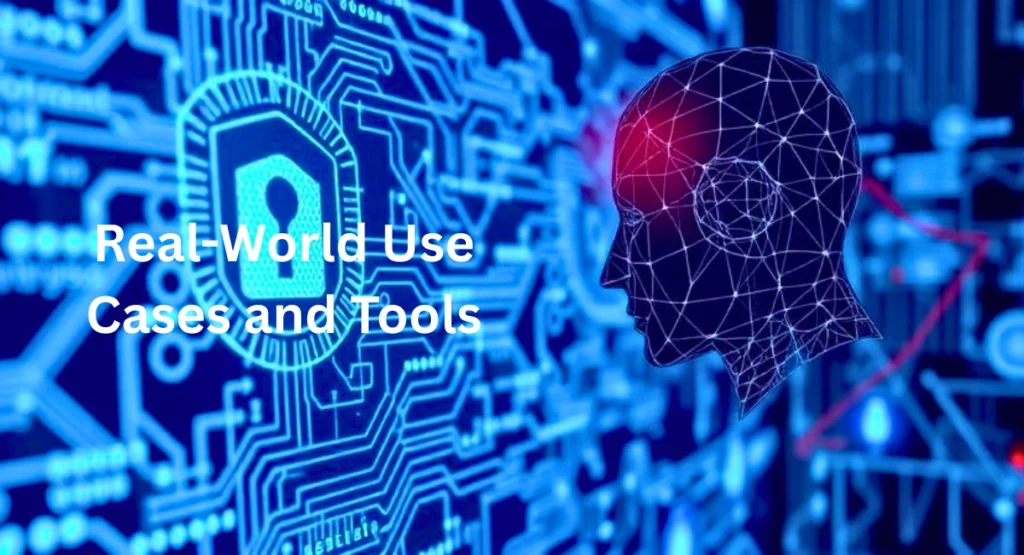How Generative AI Can Be Used in Cybersecurity?

We have been witnessing the increased usage of generative AI models in work automation and content creation. But did you know that one of the wide use cases of generative AI is in cybersecurity? Yes! It is true.
Cyber threats are increasing at an unprecedented rate, outpacing traditional defenses and frustrating cybersecurity teams. To smartly detect sophisticated threats and mitigate risks, 47% of the businesses are already using Gen AI.
Additionally, Gen AI in cybersecurity has dynamically transformed the way security professionals detect, forecast, and respond to malware. From generating phishing simulations to automating threat discovery and incident response, generative AI is the need of the hour.
In this article, we will explore how generative AI can be used in cybersecurity, its key benefits, impacts, and real-world use cases.
What is Generative AI?

Generative is a double-edged sword in the digital landscape, but what exactly is it? Simply put, it is known as a class of artificial intelligence that efficiently creates new content such as images, code, text, or audio by learning patterns from previous data. In short, these models do not just analyze; they generate.
For instance, the most common example of Gen AI is Large Language Models such as ChatGPT that help you in everything, from suggesting code, generating content, and even detecting malware and cyber attacks.
Types of Generative AI
Here are the most common types of generative AI used in cybersecurity:
Generative AI Models | Description | Cybersecurity Key Applications |
Large Language Models (LLMs) | Includes NLP models like GPT, BERT, PaLM that give human-like text | Threat summarization, phishing simulations, automated reporting, and policy generation |
Generative Adversarial Networks (GANs) | Two-part neural networks that give realistic synthetic data | Deepfake/scam detection, malware simulation, adversarial training, and synthetic dataset generation |
Variational Autoencoders (VAEs) | Neural models that generate data by learning latent variables | Anomaly detection, data compression, and intrusion simulation |
Transformer Models | Sequence models to perform tasks like translation and summarization | Log summarization, behavioural analysis, threat report automation |
Diffusion Models | AI models that iteratively produce high-quality synthetic data | Simulated attack environments, synthetic training data generation |
Fine-tuned Proprietary Models | Domain-specific models trained on security data | SOC operations, alert triage, real-time detection, and response |
Role of Generative AI in Enhancing Traditional Cybersecurity Methods
The emerging threats need advanced and proactive techniques. Traditional cybersecurity heavily depends on rule-based systems and reactive approaches. Here’s how generative AI enhances the traditional techniques:
- Proactively Detecting Phishing Attacks: The AI models can help flag anomalies and prevent potential security breaches before they occur.
- Speeding Up Incident Response: LLMs evoke real-time response plans, generate summaries, and recommendations according to threat context.
- Reducing Human Analyst Workload: Well, these AI models aid in automating repetitive tasks like log analysis, threat scoring, and threat detection.
- Improving Threat Intelligence: Generative AI enables cross-references to internal alerts with global threat databases and gives data-driven insights to improve security posture.
Benefits of Using Generative AI in Cybersecurity
Generative AI brings enormous benefits to the cybersecurity landscape. Here’s how it is an advantage for security teams and businesses.

Faster Detection and Response
Generative AI dramatically decreases the Mean Time to Detect (MTTD) and Mean Time to Respond (MTTR) to cyber attacks. By predominantly detecting system logs, network traffic, and user behavior, these models can quickly analyze data to detect anomalies and initiate an automated response.
Addressing Security Talent Shortages
The cybersecurity domain is becoming competitive day by day, and for this, many organizations find it difficult to hire and keep skilled cybersecurity professionals.
Generative AI aids in bridging the gap by replicating the capabilities of understaffed Security Operations Centers (SOCs). These AI-driven systems perform all the tasks security professionals do and develop a defence against known and emerging threats.
Cost Reduction through Automation
Well, performing manual threat detection, incident response, and compliance tasks can be expensive. Generative AI helps in automating many of these repetitive tasks, such as log analysis, policy generation, and patch suggestions, cutting out operational costs and limiting the need for broad scripting.
Enhanced Threat Intelligence
Artificial intelligence models, particularly those trained on wide threat data, can detect real-time threats and forecast emerging attack patterns. Moreover, they develop threat feeds, dark web chatter, and telemetry data into actionable insights, assisting businesses to stay competitive with threat actors with less manual input.
Improved Accuracy and Cyber Defense
Traditional cybersecurity models often generate a higher risk of false positives. Modern AI, particularly Gen AI through contextual pattern recognition and deep learning, can dramatically rescue these inaccuracies.
Moreover, it also differentiates between subtle anomalies and accurate threats with higher accuracy, leading to quick and effective alert management and fewer distractions for analysts.
Key Applications of Generative AI in Cybersecurity
Since Generative AI acts as a double-edged sword in cybersecurity, it has wide use cases. Let’s explore some of its key applications in the modern cybersecurity realm.

1. Cybersecurity Threats Identification and Anomaly Detection
The evolving threats make businesses use Gen AI in different use cases. The most important aspect is that generative AI models detect anomalies, identify patterns, and suspicious behaviors across a wide range of data. It can detect changes and intrusions in real-time by learning normal network behaviours.
For instance, it uses techniques like unsupervised learning and pattern recognition to check previously unknown threats, even when limited labeled data is available. Additionally, predictive modelling aids in predicting attacks according to evolving threat patterns, enhancing overall security posture and defense.
2. Automating Incident Response Strategies and Threat Hunting
Detecting threats and security weaknesses before they become vulnerable is crucial in cybersecurity, and for this, timing plays a key role. Generative AI speeds up incident response by automating threat hunting, classification, and prioritization.
AI-generated playbooks help cybersecurity professionals through customized, situation-specific workflows. Moreover, these models continuously learn from new incidents and sophisticated cyber attacks to enhance response accuracy and simplify threat actor hunting. They also help security teams by identifying compromise paths and mitigation techniques.
3. Cybersecurity Training & Simulation
Generative AI models are also useful in giving training to red and blue teams by creating complex, realistic attack scenarios. This will help them improve practical readiness without real-world risk.
Additionally, it also generates synthetic datasets replicating sophisticated attacks, optimizing model training without breaching user privacy or data leakage concerns. Overall, it results in solid machine learning defenses and more powerful human operators.
4. Phishing Identification and Email Filtering
Generative AI, particularly LLMs, is best suited to detect language patterns in emails to flag phishing and social engineering attacks. They can generate phishing content to train filters or test employees in a practical environment.
Moreover, it also enables cutting-edge spam detection to make it more accurate through frequent adaptation to malicious code and attacks.
5. Secure Code Generation and Vulnerability Patching
AI systems are also efficient in generating secure code snippets. Generative AI tools can quickly analyze the issues, generate code tailored to patch, and even test their effectiveness. This aids cybersecurity professionals in reducing false positives and making it impossible for attackers to exploit vulnerabilities.
Furthermore, such systems learn secure coding patterns and actively suggest improvements, limiting the developer’s cognitive load and enhancing software integrity.
6. Identity and Access Management (IAM)
Generative AI improves IAM by mimicking behavioral biometrics such as typing patterns, navigation habits, or login frequency to confirm identity. When security incidents occur (e.g., location-based irregularities or session hijacking), the system initiates alerts or additional verification steps, allowing adaptive authentication.
7. Policy and Documentation Automation
As the AI models evolve, it highlights the importance of staying compliant. By assessing regulatory frameworks and past documentations, digital AI tools can help you draft cybersecurity policies, compliance checklists, audit documentations, and breach reports. This not only saves time but ensures accuracy and readiness for audits.
Real-World Use Cases and Tools

Here are some popular Gen AI tools and how we can use them in real-world scenarios:
Tool | Description | Use Case |
IBM QRadar Suite | A generative AI threat detection and response platform | AI-powered threat detection, response, and SIEM |
VirusTotal Code Insight | Uses LLMs to detect suspicious code and create malware samples | Static assessment of malicious scripts and binaries |
FoxGPT (ZeroFox) | Domain-specific LLM-based cybersecurity assistant for digital risk and data protection | Threat intel summaries, dark web monitoring |
Tenable ExposureAI | An AI-assisted software vulnerability management tool by Tenable | Predictive risk scoring, exposure insights |
Google Threat Intelligence | Links LLMs with Google Cloud to give AI-based threat insights | Real-time threat detection and context enrichment |
Secureframe Comply AI | Automates risk assessments, policy generation, and compliance tracking | SOC 2, ISO 27001, and other audit-ready reporting |
Case Studies from Different Industries
- IBM: Use generative AI in its QRadar suite to decrease alert fatigue, allowing quicker threat detection and more efficient incident response through automated summaries and guides.
- Google Cloud: Using LLMs along with a threat intelligence platform to assess vast data streams, leading to quicker detection of nation-state attacks and improved phishing email detection across Gmail. Overall, it used Gen AI for data security.
- Secureframe: Used its Comply AI to automate risk analysis, creating real-time remediation steps and limiting the load of compliance preparation for quick scaling startups.
- Tenable: Integrated ExposureAI to transform reactive to proactive security. The system analyzes potential exploitation paths according to generative risk modeling, aiding in prioritizing patching techniques more smartly.
Risks and Challenges of Generative AI in Cybersecurity
Well, employing generative AI offers several benefits and has wide applications, but it also poses potential risks and challenges that are important to address.

Adversarial Use of Generative AI
While generative AI improves cyber defenses, it also allows attacks with modern abilities:
- AI-generated phishing emails are more compelling, convincing, personalized, and easily bypass traditional spam filters.
- Blackmailers can easily use deepfakes for identity fraud or executive impersonation in social engineering attacks.
- AI generates malware and zero-day vulnerabilities, which can be tested and deployed at scale, making cyberattacks more intelligent and harder to find.
Model Vulnerabilities and Bias
Generative AI can also be easily manipulated:
- Poisoning attacks can add malicious actors or misleading data into training sets, questioning the model’s integrity.
- Gen AI also leads to model hallucinations, meaning AI generates inaccurate or absurd outputs that can misguide analysts or workflow automation.
- Moreover, bias in data might be another issue that may cause the model to ignore potential threats or prioritize responses inaccurately.
Compliance and Data Privacy Issues
Training AI models requires a large amount of data:
- It means this must include proprietary, sensitive information or customer data, raising compliance issues under regulations like GDPR, HIPAA, or CCPA.
- Moreover, it is important to monitor data, as unclear data regulation practices result in unintended exposure or legal liability due to the misuse of data in AI pipelines.
Security of AI Pipeline
It is crucial to secure AI systems:
- If not properly protected, AI systems, model weights, training data, and API can all shift into threat vectors.
- Threat actors also manipulate AI systems or reverse-engineer, resulting in sensitive data leakage, unauthorized access, new threats, or model corruption.
- Moreover, ensuring end-to-end security of the AI development and deployment lifecycle is becoming a crucial aspect of cybersecurity strategy.
Best Practices for Implementing Gen AI in Cybersecurity
To utilize the full potential of generative AI capabilities while reducing sophisticated cyberattacks, organizations should follow some ethical and practical guidelines.

Combine AI Tools with Regulatory Compliance Frameworks
Ensure to use AI security tools and integrate the ones that comply with regulatory frameworks like NIST, ISO/IEC 27001, and GDPR. This helps in risk management, data privacy, and system integrity.
Human Experts and AI Collaboration
Generative AI should be used as an assistant, not a human cybersecurity experts replacement. It is crucial to maintain human oversight in complex decisions, especially during threat response and policy enforcement.
Regular Monitoring and Feedback Loops
Make sure to audit AI outputs and monitor model performance. Integrate closed-loop systems where security analyst feedback is used to optimize models and limit hallucinations.
Training Models with Diverse and Representative Datasets
Implement a wide and inclusive range of threat data to stop model bias and improve accuracy across different attack vectors and ecosystems.
Conclusion
As the cybersecurity landscape becomes significantly complex and cyber defense becomes more sophisticated, generative AI is a critical component in modern digital defense. From improving threat detection and automated workflows to enabling sophisticated attacks and reducing human error, Gen AI gives revolutionary benefits to security systems and teams.
However, with its power comes several risks. The same models that protect can also be used to manipulate models by creating phishing emails and malicious code. For this, you need a blend of AI and a human-centric approach to implement safe and ethical AI.
In short, the present and future of cybersecurity is generative, and the time is to prepare now.
FAQs
How does AI contribute to cybersecurity?
- AI improves cybersecurity by automating threat detection, assessing vast data for malware, and speeding up incident response.
What are the benefits of generative AI in cybersecurity?
- Generative AI offers several benefits, including better threat intelligence, increased response time, reduced false positives, and automating security tasks.
What is generative AI in the cybersecurity market?
- In the cybersecurity market, Gen AI is an expanding industry segment that focuses on using gen AI models to detect threat actors, prevent, and respond to cyber threats.






